Late summer stars of the garden
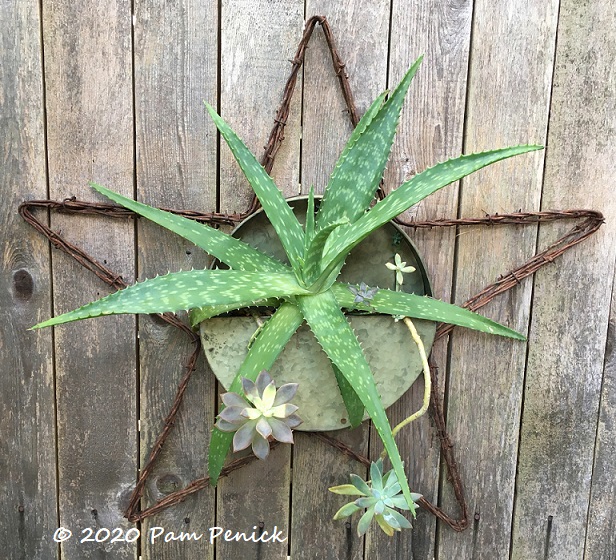
Like a starfish clinging to a rock, this soap aloe (Aloe maculata) I stuck in a pie-pan planter has grown more beautifully than I expected. It seems to love the crevice life. Snaking stems of ghost plant (Graptopetalum paraguayense) add their flower shapes to the composition. A barbed-wire star completes the astral look.
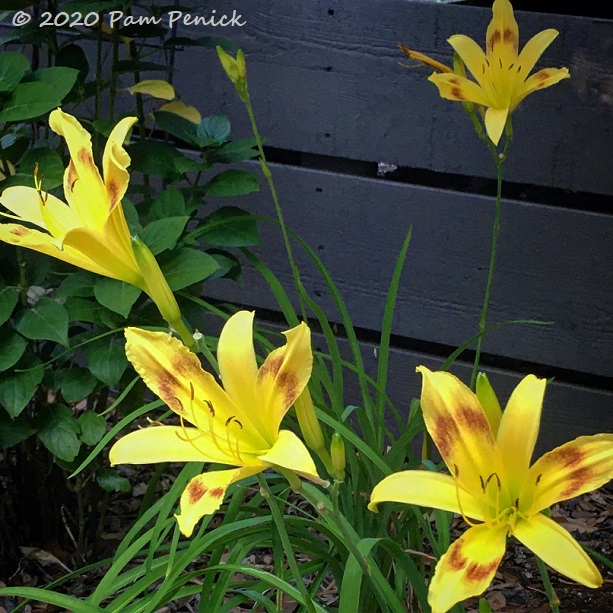
Come meander around the garden with me. This is what I do every day, snapping photos with my ancient phone of whatever catches my eye. Here’s ‘Wilson’s Yellow’ daylily, blooming in late August instead of early summer like it usually does. Weird but welcome!
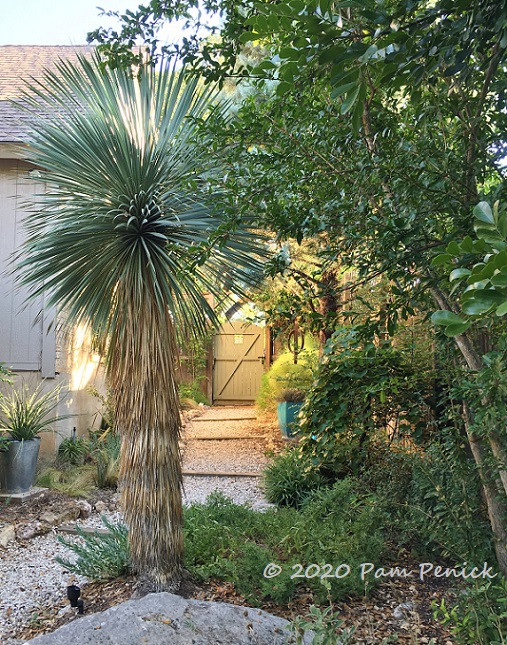
‘Sapphire Skies’ Yucca rostrata stands tall alongside the path up to the eastern gate. Its bristly head now stands high enough for us to see it from the elevated deck. From this vantage down by the shed, it towers over me.
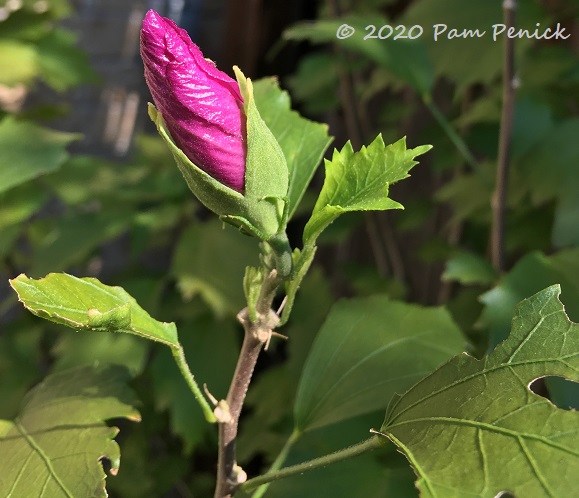
Just inside the gate, ‘Purple Pillar’ rose of Sharon (Hibiscus syriacus ‘Purple Pillar’), a trial plant from Proven Winners, continues to pump out cerise blossoms.
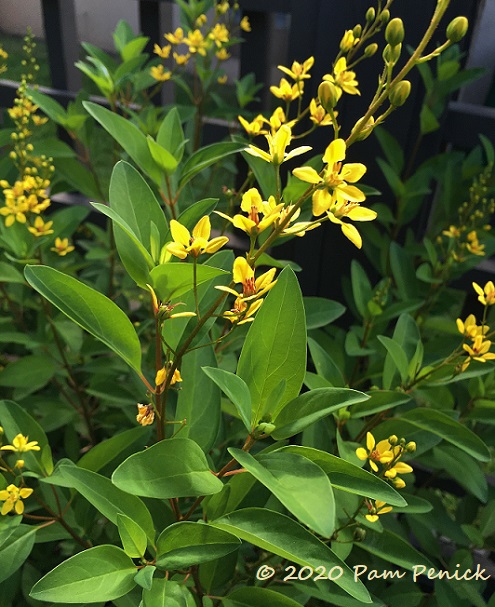
Outside the gate — we’re in deer territory now — I’m growing a trio of golden thryallis (Galphimia gracilis) in dappled shade — and they couldn’t be happier. As they grow I plan to hedge them, since this is a narrow space, an idea I’m stealing from Ruthie Burrus’s garden.
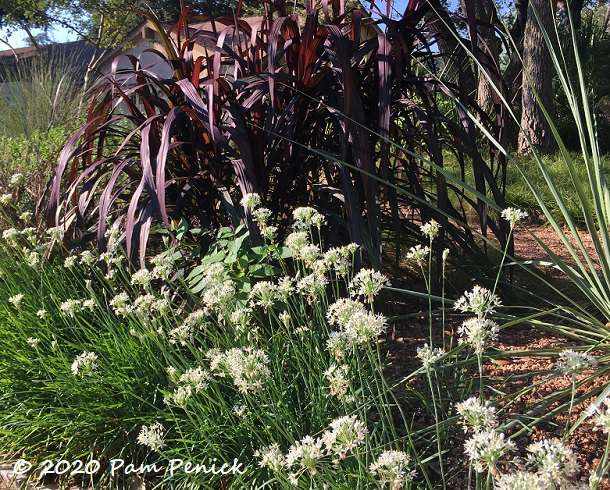
In the hellstrip garden — which isn’t so hellish since it receives only morning sun — the garlic chives (Allium tuberosum) are blooming, a sign that summer is waning. Hallelujah! ‘Vertigo’ pennisetum has finally achieved its late-summer girth and looks like I want it to look all summer. Alas, it takes a while to get going (too much shade perhaps?) and doesn’t really fill out until July.
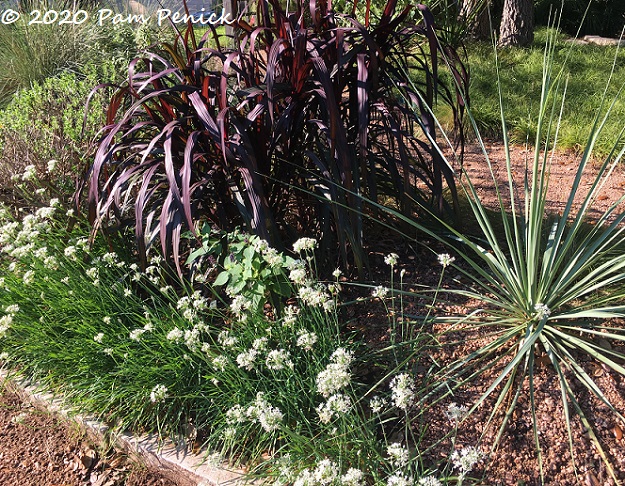
The blue sea urchin on the right is a young Nolina nelsonii, which replaces Mexican oregano that struggled here (again, lack of sun, probably).
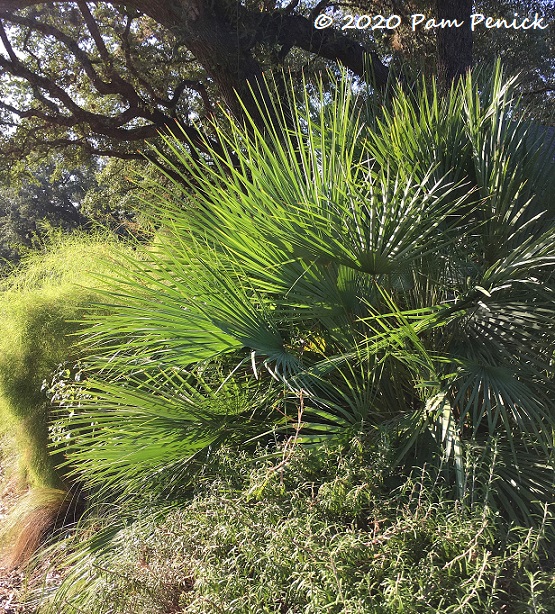
In the island bed, the silver Mediterranean fan palm (Chamaerops humilis var. argentea) is finally getting big! What a slow grower this one is. But a beauty. It looks fairly green in this photo, but at other times its narrow leaves have a distinct silvery-blue hue. Bamboo muhly in the background and rosemary in the foreground thrive in the same conditions and resist deer incursions.
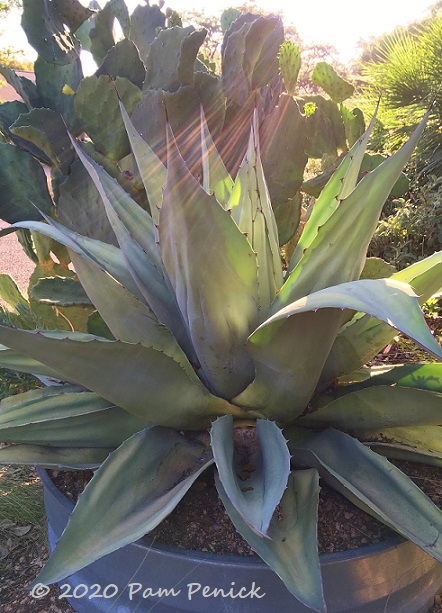
‘Vanzie’ whale’s tongue agave (Agave ovatifolia ‘Vanzie’) flexes his flippers in the galvanized fire-ring planter. Check out those deeply channeled leaves, a ‘Vanzie’ hallmark. It looks like someone making a U-shape with their tongue.
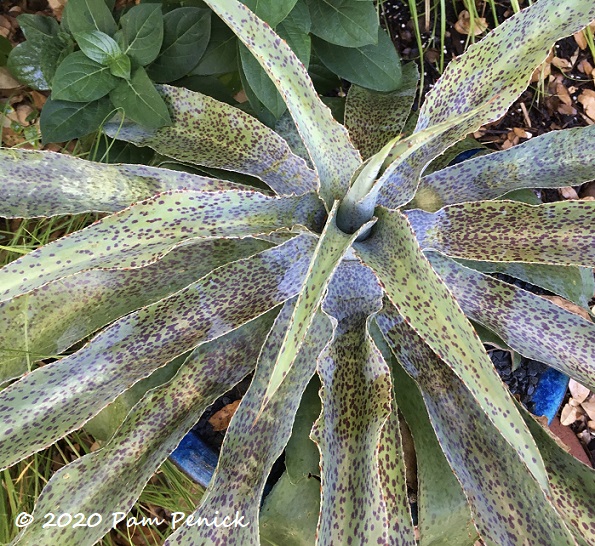
Heading back into the rear garden — farewell, deer! — I have to stop and admire ‘Spotty Dotty’ mangave’s wavy, purple-speckled leaves. When the Philippine violet behind it starts flowering, it should make a pretty duet.
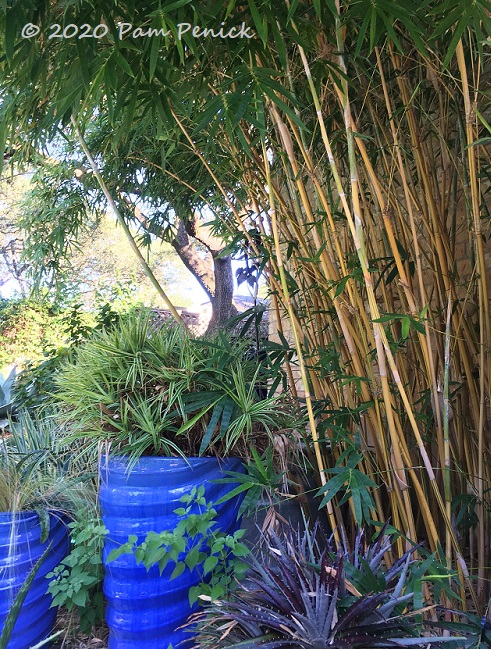
A tropicalesque combo grows nearby: ‘Alphonse Karr’ bamboo (Bambusa multiplex ‘Alphonse Karr’), ‘Sparkler’ sedge (Carex phyllocephala ‘Sparkler’) in the blue pot, and maroon ‘Burgundy Ice’ dyckia.
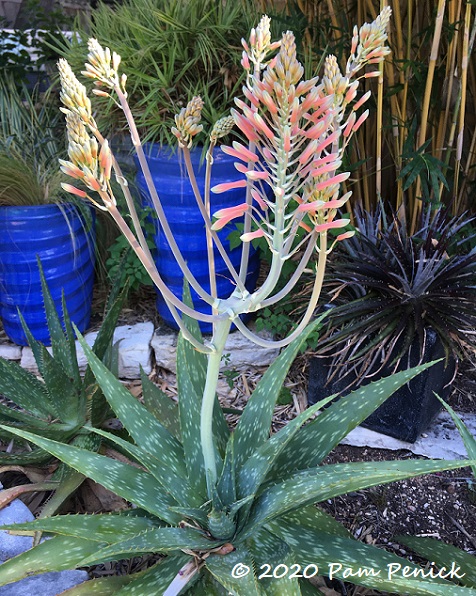
A trio of soap aloes grows here, which I keep as solitary specimens by pulling out pups by the dozens all year. The center one is flowering again, for maybe the third time this year.
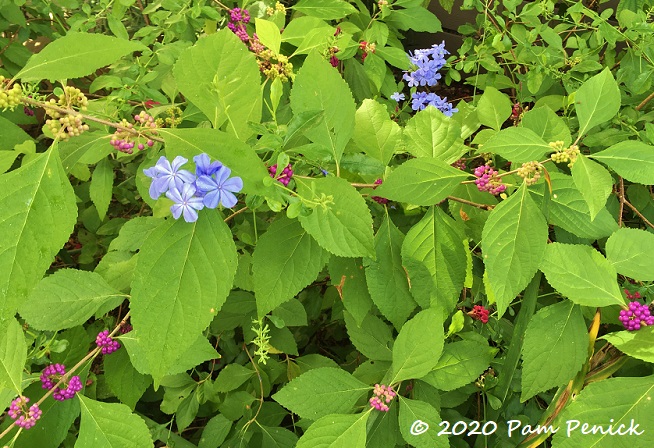
Plumbago (Plumbago auriculata) nestles under an American beautyberry (Callicarpa americana), whose berries are purpling up, another sign that fall is coming.
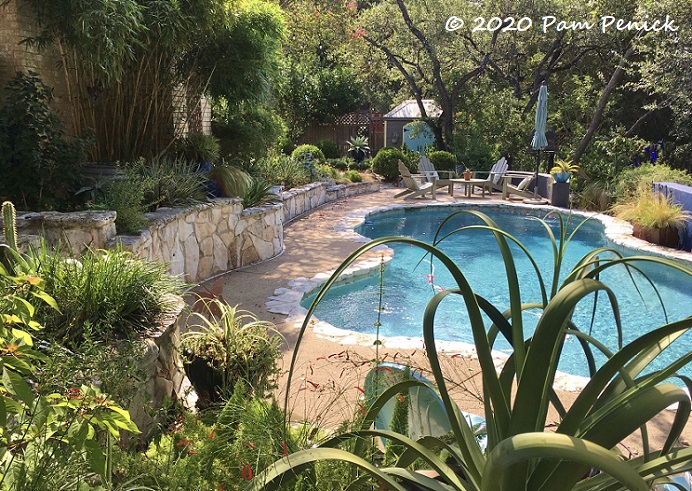
But for now summer still reigns, and it will until early October. One more month until our second spring arrives in central Texas.
__________________________
Digging Deeper
Come learn about gardening and design at Garden Spark! I organize in-person talks by inspiring designers, landscape architects, authors, and gardeners a few times a year in Austin. These are limited-attendance events that sell out quickly, so join the Garden Spark email list to be notified in advance; simply click this link and ask to be added. Season 8 kicks off in fall 2024. Stay tuned for more info!


Your garden is looking fantastic, Pam! I was immediately taken by the Galphimia gracilis, which I haven’t seen before. My Sunset Western Garden doesn’t even list the genus, which wasn’t a positive sign but I found a 2016 post by a SoCal extolling its fitness for our Mediterranean climate. I even found a source for the plants, albeit not one based in California.
Kris, you might not have noticed Galphimia during the Austin Fling because we were coming out of a harsh winter, and the plant had probably died to the roots that year and was just coming back. For the past several years mine have had no die-back whatsoever, and they are glorious — until the next time we get a stretch of 20-degree nights. You aren’t likely to have that issue in L.A. — yay! Perhaps it needs the humidity or extra moisture of its native range in Central America, although I don’t find it especially thirsty in Austin. All this is to say, I think it’s definitely worth a shot, and I’m surprised you don’t see it in Southern California already.
Your garden is looking very serene; quite the feat this time of year! If you’ve commented on painting your culvert pipe planters before, I’ve somehow missed it. They look nice in blue.
Thanks, Maggie. Those blue pots are ceramic actually! I still have my galvanized culvert planters (unpainted) too, although they don’t appear in this post. 🙂
Oh ‘Vanzie’!!!
He’s a pretty one.
The pie-pan planter is a great success, Pam. Love the sunbeams coming in through the whale’s tongue agave.
I am also fascinated with the pie pan planter and will look for an old one in my garage this afternoon. Super cute idea.
Karin, to clarify, it’s not actually an old pie pan. It resembles one, but it has a pocket built in to hold soil. Click the link in that paragraph to see how that pan looked before I planted it.
Thanks, Pat. I’m pretty happy with how the aloe took to it.
Love all the Agave. Gives us inspiration. I bought my first one this month. Have it in a pot for now.
We went to Tequilla last fall and I feel in love with Agave plants. I hope mine will be as Wonderful
as yours are!
I remember when I first fell in love with agaves. It was while reading Tom Spencer’s blog Soul of the Garden, where he posted frequently about his agave collection. And now I can’t imagine gardening without them. I hope it will be so for you too!
Pam, your garden looks better than ever! Question: does your ‘Purple Pillar” althea attract and support hummingbirds? Also, who pollinates your Galphimia blanca?
Peter, I don’t know because it’s planted on the far side of the house where I don’t go very often. But it has performed so well in that neglected spot that I’m planting another this fall by my deck, so I shall be able to observe it more closely next year. I do have a lot of hummingbird activity in my garden, and they definitely love Mexican honeysuckle, Turk’s cap, aloe, beebalm, salvia, and Mexican orchid tree. I’m sorry to say that Galphimia gracilis doesn’t seem to attract many pollinators in my garden. Maybe less showy pollinators find it, like tiny bees or beetles. I’ll have to observe more closely.
Don’t know about Purple Pillar, but my old fashioned, spreading Althea really draws hummingbirds. I bet Pillar would, too, with those same funnel flowers.
I am really getting into columnar plants lately. I read it takes guts to plant a tall skinny plant, ha! Althea might be fun to try.
Your garden looks good Pam. I found myself rolling my tongue after reading your description of the Whales tongue agave. Tee hee…
Ha! Vanzie would be proud.
Glad to see you are growing Callicarpa americana! Mostly I see the exotic beautyberries in gardens. I dug up two americanas from my meadow and they fit nicely into my woodland garden. One is about 6 ft tall now, and so handsome. He’s underplanted with a black ajuga. Berries are edible, but not too tasty, so I leave them for the birds.
American beautyberry is by far the most common beautyberry I see in Austin. Perhaps it just performs the best in our extreme heat and humidity. I also have Mexican beautyberry, which has done well for me but is a bit of a beast at about 8 feet tall.
Good point: Japanese BB might not do well for you in Austin. I do see it here a lot on the east coast, though. We grow so much Japanese stuff, as you know from Charlotte. And I did not even know of Mexican BB; amazing how one parent plant from long ago adapted to such a variety of conditions, and is native to so many disparate areas. To be found in multiple places, it must really be an important part of local ecologies.
That’s a great observation, Julie. It definitely attracts songbirds to our gardens. And it is a wonderful plant for us Southern gardeners especially, being a harbinger of fall that gives us hope we’ll survive the summer heat — ha!
I’m always intrigued at the unique plants you highlight, so foreign to my Ohio garden. But I must admit that I gave a little shudder seeing your plumbago. After behaving itself for years, it is suddenly intent on world domination. Thinning it out is proving nearly impossible, especially the section where poison ivy snakes through it. Argh!
Yikes! I would give a shudder too, Robin. Good luck taming your plumbago beast!